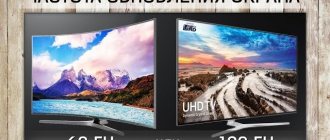TVs with a screen diagonal of over 42 inches are in unprecedented demand in the market. The phenomenon is due to the fact that about 75% of consumers believe that the larger the display, the better the image it reproduces. The statement is not entirely correct, since the clarity, naturalness of colors and good sharpness of the image depend on the resolution of the TV monitor. The viewing distance and the characteristics of the incoming signal are also important. Let's find out what is the best TV screen resolution to choose, based on its purpose and operating conditions. At the same time, let’s define the existing types of screens.
Review of manufacturers
In 2021, the model range of almost every manufacturer includes TVs with HD, Full HD and Ultra HD resolutions. This applies to both well-known brands (for example, Samsung, Sony, LG, Philips, etc.) and little-known brands.
Advice! With an equal number of pixels in devices from different manufacturers, other characteristics will also affect the clarity of the picture - brightness, color, matrix, etc., so it’s worth comparing by image quality in general, and not by pixel density.
Among brands that have the same resolution, lesser-known companies will have lower prices. Devices made by Sony will be the most expensive. Equipment from Samsung is sold a little cheaper. Approximately in the middle are TVs from LG and Philips. So, the table below shows TVs with Full HD resolution.
| Brand and model | Diagonal, in inches | Screen resolution | Cost, rub |
| Supra STV-LC40LT0010F | 40 | Full HD | 15690 |
| BBK 40LEX-5056/FT2C | 40 | Full HD | 16890 |
| Philips 40PFS4052 | 40 | Full HD | 21890 |
| LG 43LJ515V | 43 | Full HD | 22890 |
| Samsung 43N5000AU | 43 | Full HD | 24990 |
| Sony 40RE353 | 40 | Full HD | 27990 |
Supra STV-LC40LT0010F on Yandex Market
BBK 40LEX-5056/FT2C on Yandex Market Philips 40PFS4052 on Yandex Market LG 43LJ515V on Yandex Market Samsung 43N5000AU on Yandex Market Sony 40RE353 on Yandex Market The table shows prices for TV receiver models according to Yandex Market. The most budget devices of each brand were selected, without any additional options (Smart TV, Wi-Fi, etc.). LG and Samsung TV receivers are presented in 43-inch sizes, because... The 40-inch diagonal is not included in the model range.
So, in order to enjoy a high-quality picture using the maximum screen resolution capabilities, when choosing a TV you should take into account several factors that were given above. However, it is worth taking into account the speed of progress in this area, so that in a year or two the purchased model will also be relevant.
A little about sweep
Along with the number of pixels located in the horizontal and vertical plane, the image in projection and panel screens is influenced by the type of scanning. She may be:
- interlaced and has the designation “i”;
- progressive, denoted as “p”.
In the first case, the picture is updated in 2 stages every 30 seconds, first even, then odd. This effect in a lit room, with an increased degree of ultraviolet rays, can cause flickering. Progressive scan is better: it has a positive effect on image quality because it updates all lines simultaneously every minute.
The quality of playback also depends on the decomposition of the signal and is divided into the following types: SDTV, EDTV, HDTV and stand for standard signal definition, enhanced and high, respectively. These indicators are grouped and determine the type of resolution.
Full HD
Full HD
The most common standard. The resolution is 1920 x 1080 pixels. The prefix “Full” is used in the name of the standard for a reason. This means that the screen is capable of reproducing HD standards, with a density of 720p and 1080p. This includes:
- movies (DVD, Blu-ray discs);
- digital channels;
- HD channels (satellite and cable TV);
- HD and Full HD content from the Internet.
The output image is clear, detailed, with color reproduction close to natural. In terms of price, TV panels with FHD resolution are slightly more expensive than their counterparts with HDR screens.
Content:
LCD TVs with a screen diagonal of more than 42 inches have been in high demand in the market in recent years. The rapid growth in popularity of large models is due to the fact that most consumers firmly believe that there is a close relationship between the size of the display and the quality of the picture it reproduces.
But this statement is not entirely true, since the naturalness, clarity and sharpness of the image are primarily determined by the resolution of the TV monitor. The characteristics of the incoming signal and viewing distance are equally important. So how can you find out the TV resolution and not make a mistake in choosing the optimal screen option? In fact, there is nothing complicated here and absolutely anyone can get an answer to this question if they want.
How to choose a sound
When choosing a new device, you should pay attention to the sound quality. The number of sound channels on a TV is indicated by two numbers, for example, “2.0”, where 2 is the number of high-frequency channels, 0 is the number of low-frequency channels.
If good sound is important to you and you want to hear all the special sound effects, choose a TV with the Dolby Digital or Dolby Digital Plus audio codec - they provide clear and spacious sound. The difference between DD and DD Plus is that the first reproduces 5.1 sound, and the second - 7.1.
Pay attention to the sound enhancement features that manufacturers offer. Some TV models have a built-in sound enhancement system that simulates surround sound, while others automatically adapt the sound to the room in which the TV is located.
Haier TVs have a Simulated Surround Sound feature that creates a live and surround sound effect without connecting additional speakers.
Which resolution is better
When choosing the optimal resolution for a future TV, it is necessary, first of all, to take into account the features of its operation.
Selecting DVD Resolution
If a TV is purchased primarily for watching movies from DVDs - in schools and kindergartens, buses and minibuses, for karaoke bars, etc., then you should give preference to budget models with a relatively low resolution. This is due to the fact that DVD videos are primarily recorded in the 720*576 format. Even if the TV screen has a higher resolution, it will still not be possible to change the picture quality for the better.
Content:
LCD TVs with a screen diagonal of more than 42 inches have been in high demand in the market in recent years. The rapid growth in popularity of large models is due to the fact that most consumers firmly believe that there is a close relationship between the size of the display and the quality of the picture it reproduces.
But this statement is not entirely true, since the naturalness, clarity and sharpness of the image are primarily determined by the resolution of the TV monitor. The characteristics of the incoming signal and viewing distance are equally important. So how can you find out the TV resolution and not make a mistake in choosing the optimal screen option? In fact, there is nothing complicated here and absolutely anyone can get an answer to this question if they want.
What types of permissions are there?
Resolution in television equipment terms refers to the number of pixels that make up the image on a television. A single pixel, or individual picture element, consists of a tiny dot on the monitor.
There are a variety of resolutions available on flat panel TVs. Older ones and many 32-inch models sold today have a million pixels or so (720p). Newer larger displays (typically 49 inches and smaller) have just over 2 million pixels (1080p). Even newer and larger TVs (typically 50 inches and above, although numerous smaller sizes) have 8 million (for 4K Ultra HD).
And the newest, largest and most expensive screens have more than 33 million pixels (8K). You'll need to look closely or pull out a magnifying glass to distinguish each one.
REFERENCE! Pixel count is one of the most common specifications used to sell TVs, partly because "4K" and "8K" sound really high-tech and impressive.
It is worth noting that this characteristic is not the most important component of image quality.
Just because a display has a higher resolution than another doesn't always mean it looks better. A TV with better high dynamic range (HDR) performance, better overall contrast ratio, or better color will look better than one with more pixels.
However, it is necessary to know the different resolutions used by television creators.











